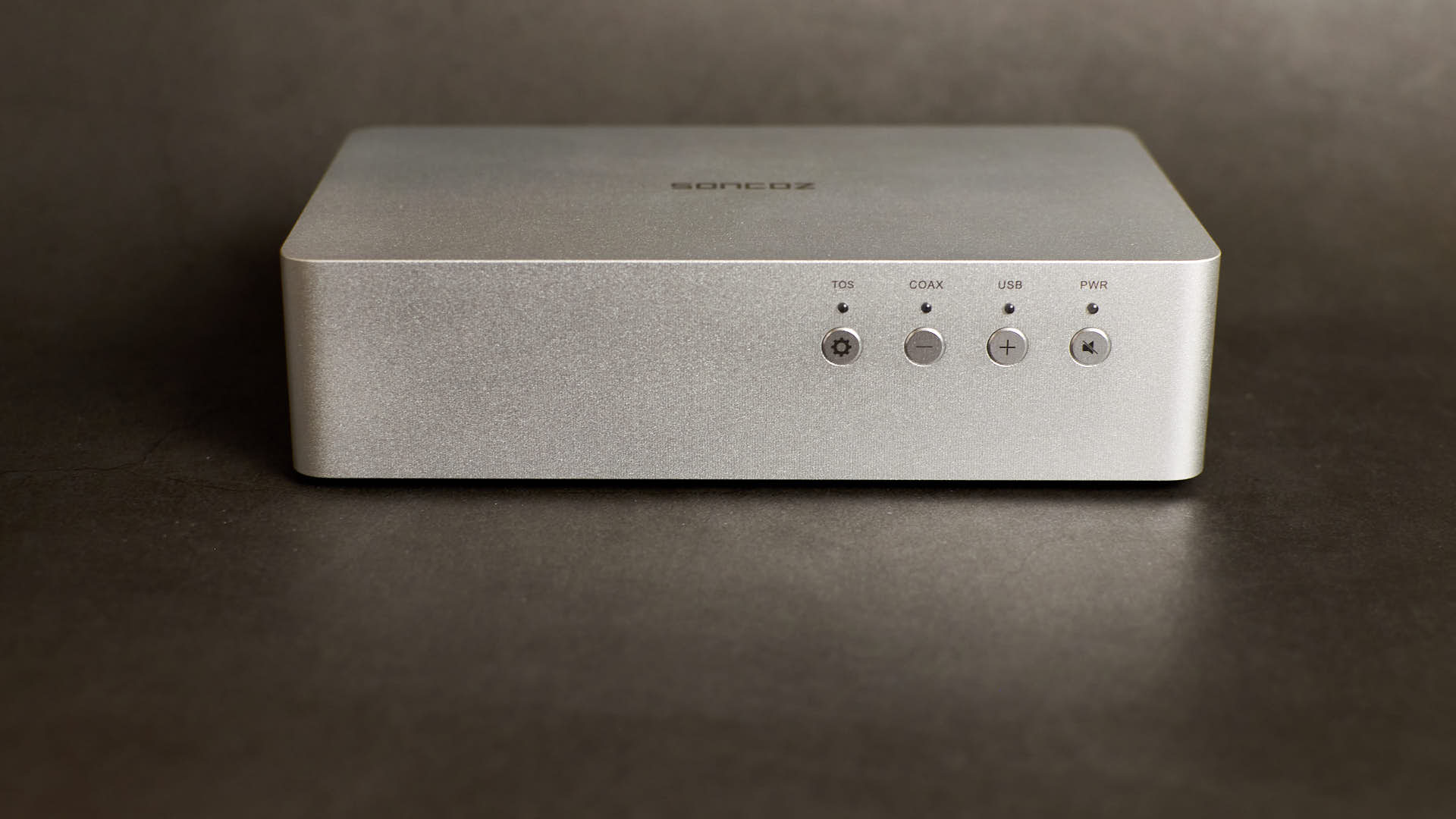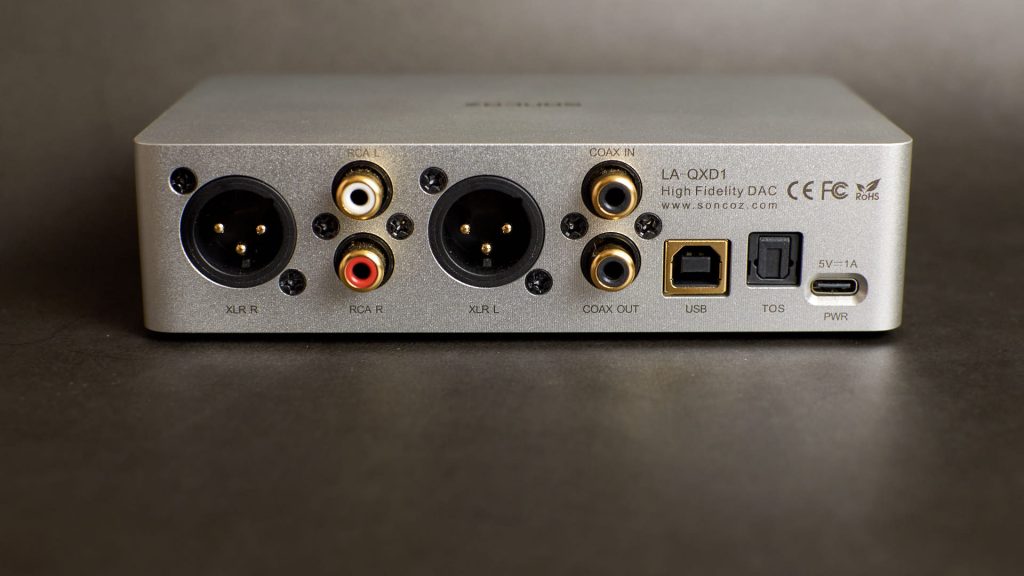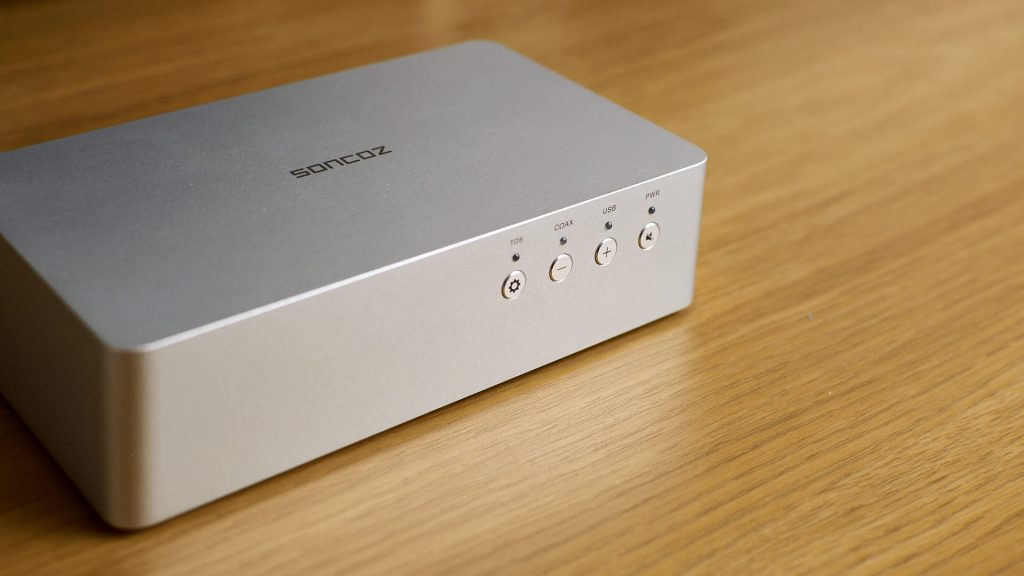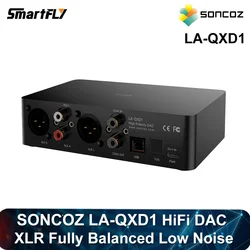I have to admit that Soncoz as a brand flew completely under my radar before the LA-QXD1, but thanks to HiFiGo who offered me a review unit for a spin that was about to change.
Soncoz LA-QXD1 is centered around a familiar Sabre’s D/A conversion chip ES9038Q2M. This one is quite often used in devices at this price point but final sound quality can vary wildly depending on the circuitry around it. Finding some info on the web that the creator behind this one is the very same person that was responsible for Khadas Tone Board actually made me excited to try it out.
Package
When it finally arrived at my doorstep it was packed in a box with bare essentials – two USB cables for signal and power, but without power supply which you’ll have to provide yourself. LA-QXD1 uses 5 V and requires 1 A so any mobile charger will do. That said, a decent low noise power supply would be even better of course.
Build and Connectivity
Taken out of the box, Soncoz LA-QXD1 immediately leaves a good impression. Matt aluminum case looks stylish and feels solid too. Buttons are small but pleasantly clicky and responsive. Great job so far.
Turn the unit around and you’ll find a set of usual inputs – USB, optical, and coaxial. Much less usual is digital coaxial output and its presence means that LA-QXD1 can act as a digital bridge. Analog out is done in two ways. The first one is a very common and widely used set of RCA connectors that every DAC unit has. Much more surprising is a pair of balanced outputs, rarely used on DACs in this price range.
Operation
When it comes to operation, it’s mostly straightforward with few exceptions. Choosing inputs, muting, and volume control function as you’d expect. One thing you should be aware of though is that every time the unit is turned off, the volume will be reset to the initial state – which is 50% as it seems.
The weird part comes when choosing one of 7 digital filters offered by Sabre DAC chip and enabled by the manufacturer to select at your will. Indication of changing these will be shown by using 3 LEDs as a circular 3 digits with 7 combinations. I suggest to simply try them out without any bias and decide which one you like the most, that is if you hear any difference at all as it is very subtle anyway. If you’re however determent to take a deeper dive into it, take a look at this table provided by the manufacturer:
Sound
I don’t really have a way of testing its balanced outs at the moment. So I used the good old RCA connectors and hooked it up to my main room setup. There, LA-QXD1 showed its character during first notes of Violent Femmes’ Please Do not Go – sounding as exciting and fast-paced as I’ve ever heard this song sound. Moving to different genres I realized how well controlled the baseline is, LA-QXD1 knows how to keep the rhythm without ever missing a step.
Going upwards, midrange is crisp and present. Both vocals and instruments are outlined with bold edges and great amount of micro-details. Moving again to the highest range, it’s again presented in a bold and crisp manner.
In terms of tonality, I wouldn’t call LA-QXD1 bright or dark but just well balanced. The biggest chunk of its character actually lies in the way it handles pace and transients. This is a fast and energetic sounding device, analytical too but mostly in a good way.
Soundstage is reasonably wide and deep, in line with any similar Sabre based DAC. On the other hand, focus and separation of each instrument is absolutely great, a notch above what I came to expect at this price range.
Comparison
Having few devices at hand I was able to compare the Soncoz LA-QXD1 with them, which helped putting its performance in yet another perspective.
Topping E30 – when switched to this budget champion you immediately notice softer presentation and a bit brighter tonality. Baseline sounds softer and a bit warmer. Sound-stage is a bit wider but not as focused. Some of you might prefer this sound signature, but to my ears LA-QXD1 is a livelier and more exciting listen overall.
EarMen TR-Amp – is a different kind of beast, battery powered with a headphone amp, but it can be used as a DAC only too. It actually uses the exact same Sabre chip and the family resemblance is there. Both rock focused and upfront type of sound, dynamic and exciting presentation. That said, I felt that TR-Amp has a bit more thump and warmth in the bass region, while LA-QXD1 offers sharper and bolder leading edges and transients.
Schiit Modi Multibit – being a multibit DAC is in a league of its own when it comes to natural timbre and soundstage depth. LA-QXD1 presents everything in a sharper and more analytical way, placing focus on transients and micro details much more than on timbre and tone body. Personally, I’m a big fan of Modi Multibit’s talents, but you can surely decide what are your own priorities.
Pairing and Conclusion
I really like the zest and energy this DAC brings to the table. Just be careful not to pair it with similarly edgy sounding gear as it might appear a bit over-caffeinated at times. Matched with a more neutral gear it should be the source of a great fun. In fact, if your system is in slumber and needs an injection of energy, or kick in a but if you will, LA-QXD1 might just be the perfect DAC for the job.
Now add great build and looks to my taste, as well as a solid set of features, and there’s really very little to complain about when it comes to Soncoz LA-QXD1.
| EARMEN TR-AMP – CHARACTERISTICS |
|
D/A converter: ESS Sabre 9038Q2M Dynamic ragne: A-W XLR > 122 dB; RCA > 122dB Dimensions: 149.3 mm(W) 87 mm(D) 37 mm(H) |
| EARMEN TR-AMP – CHARACTERISTICS |
|
D/A converter: ESS Sabre 9038Q2M Dynamic ragne: A-W XLR > 122 dB; RCA > 122dB Dimensions: 149.3 mm(W) 87 mm(D) 37 mm(H) |









Very insightful review Srboljub in comparison with E30 and Modi MB.
I am one of those who don’t appreciate forward and nervous sounding dacs, i much prefer soundstage and timbre delicacy. Out of curiosity, what power source did you use while comparing to the E30?
Thanks! I used both iFi iPower and my own DIY linear power supply (SupperTeddyReg variation).
how would this compare to the d50s?
To my ears, it’s more detailed, quicker with transients, more microdynamics, but also more analytical. In short, I feel that this is a more capable DAC but you have to be OK with its analytical and upfront nature or you might not enjoy it.